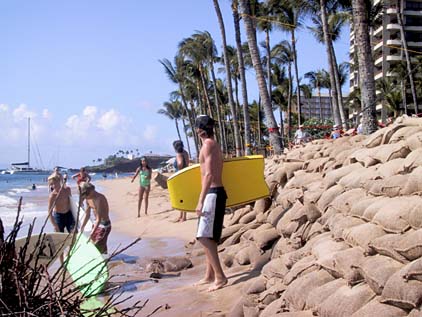
GARY T. KUBOTA / GKUBOTA@STARBULLETIN.COM
About 17,000 sandbags have been placed along the shoreline fronting Kaanapali Alii in West Maui since the resort condominium received an emergency permit from the state on July 22. Observers said the erosion appears to be lessening slowly as the summer surf subsides.
Unusual south swells
erode beach at
Kaanapali ResortTwo Maui hotels try to stop
the sand loss with artificial barriers
KAANAPALI, Hawaii >> Kaanapali Beach is ailing just three months after being ranked the nation's best beach for 2003 by "Dr. Beach."
Stephen Leatherman, a coastal expert and a professor at Florida International University in Miami, said in May that what he liked about Kaanapali is that it has a nice strand of beach that is not crowded by the hotels at the Kaanapali Beach Resort.
But sand migration caused by a persistent swell from the south this summer has wiped out the beach in front of the two hotels at the south end of Kaanapali: the Kaanapali Alii and the neighboring Maui Marriott.
The beach erosion has been so severe, the Kaanapali Alii has lost nine coconut trees and a strip of manicured grass about 30 feet wide. The only thing now separating the hotel from the ocean is a small strip of grass.
The hotel's new shoreline is some 17,000 sandbags and 25 plastic highway barriers that have been filled with sand and sunk into the ground.
Mark Altier, the Kaanapali Alii's general manager, said it is normal for the wide, sloping beach to narrow during the summer and then be replenished with sand in the winter by wave and storm action.
"In 22 years we've never lost any land," Altier said.
"It's certainly unusual," said San Lemmo, of the state Department of Land & Natural Resources' Coastal Zone Management program.
"The difference this time is that for some reason we don't completely understand -- whether from unusual ocean currents or wind patterns -- the erosion has been more serious," Lemmo said.
Charles "Chip" Fletcher, a professor of coastal geology at the University of Hawaii's Department of Geology & Geophysics, said one theory is that higher-than-normal south swells, generated by storms in the South Pacific, have arrived through the Kealaikahiki Channel, which lies between Kahoolawe and Lanai.
The strength of the swells is thus focused on West Maui's south coast, pushing the sand to the north, Fletcher said.
